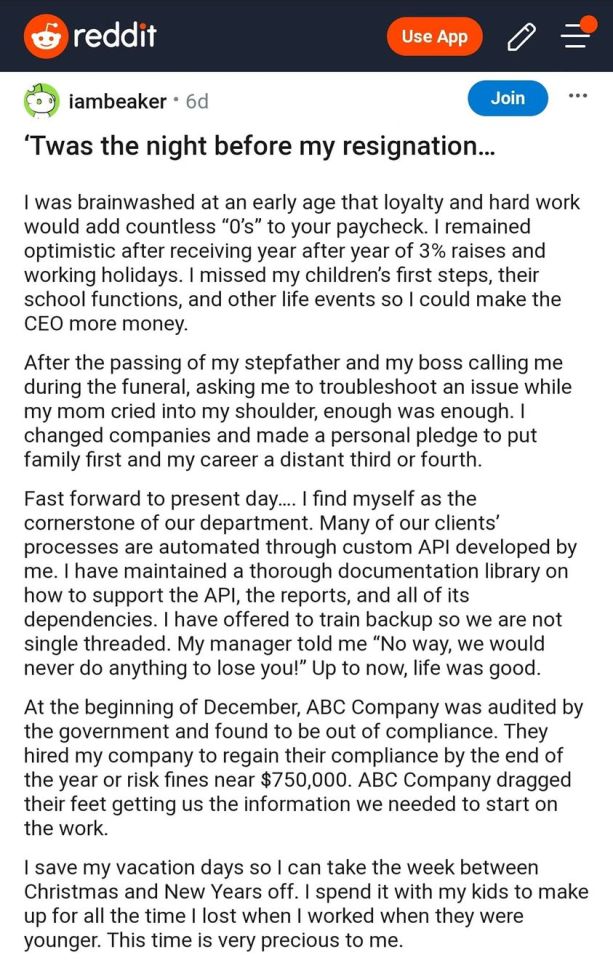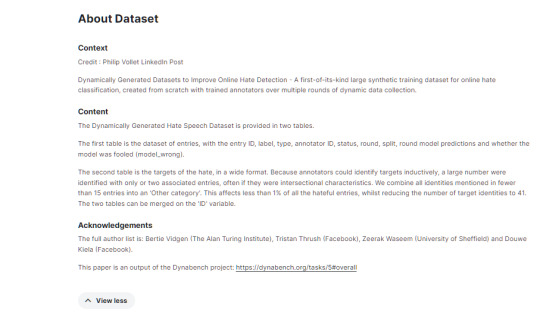#API Q1 Training
Explore tagged Tumblr posts
Text
AVN PROFESSIONAL QUALITY – Expert API Q1 Auditor Training for Quality Management Excellence
AVN PROFESSIONAL QUALITY provides industry-leading API Q1 auditor training designed to equip professionals with the knowledge and skills to audit quality management systems in accordance with API Specification Q1 standards. Our comprehensive training ensures compliance, enhances auditing capabilities, and supports continuous improvement in the oil and gas sector.

0 notes
Photo
Stealing/boosting id from consistantly-changing
[Image descriptions in order: two screenshots of a Reddit post by u/iambeaker titled "'Twas the night before my resignation…" The post reads "I was brainwashed at an early age that loyalty and hard work would add countless "0's" to your paycheck. I remained optimistic after receiving year after year of 3% raises and working holidays. I missed my children's first steps, their school functions, and other life events so I could make the CEO more money.
After the passing of my stepfather and my boss calling me during the funeral, asking me to troubleshoot an issue while my mom cried into my shoulder, enough was enough. I changed companies and made a personal pledge to put family first and my career a distant third or fourth.
Fast forward to present day…. I find myself as the cornerstone of our department. Many of our clients' processes are automated through custom API developed by me. I have maintained a thorough documentation library on how to support the API, the reports, and all of its dependencies. I have offered to train backup so we are not single threaded. My manager told me "No way, we would never do anything to lose you!" Up to now, life was good.
At the beginning of December, ABC Company was audited by the government and found to be out of compliance. They hired my company to regain their compliance by the end of the year or risk fines near $750,000. ABC Company dragged their feet getting us the information we needed to start on the work.
I save my vacation days so I can take the week between Christmas and New Years off. I spend it with my kids to make up for all the time I lost when I worked when they were younger. This time is very precious to me.]
["Last week and this week, I have been notifying the project manager and my manager about my time off. I let them know I would need ABC Company's information soon so I can start on it. I offered to work extra hours to ensure my piece would be finished prior to Christmas Eve.
On Tuesday, my manager calls me and tells me ABC Company finally sent the data over I requested over two weeks ago. He looked beaten because he knew what was about to happen. I told him who should I walk through the project with because I'm off after Christmas. My manager says, "I'm sorry. But I have to ask you to work. I declined your time next week."
I asked, "What happens to my vacation time?" My boss says, "I'm sorry. You know the rules. Use it or lose it. I fought for you but HR wouldn't budge."
I drafted my resignation letter after the call, set it to delay delivery on Monday at 8am, and closed up shop.
ABC Company will pay $700,00 because nobody knows how to program that system since there is no back up. Our other clients will be expecting their monthly, quarterly, and annual reports within the first week of January. No one knows how to do this. We had six projects in progress involving extensive API and reporting, now those projects are dead in the water. Seven clients prepaid for API and automation upgrades in 2022 Q1. I don't know what will happen to those.
Please remember. Family first. You never get that time back."]
[Several screenshots of a text conversation between OP and their boss. It goes:
Boss: Hope you have a great Christmas
Boss: [OP] please call me as soon as you can.
Boss: I received your email. I understand that you are upset but resigning is not the best choice in this circumstance.
Boss: [OP], I have been your friend for five years. I'm asking you as a friend, not a manager to reconsider and call me. Let's talk about this
Boss: Hey, you made your point. You can have today off if you call me and let me know when we can expect you tomorrow. But you need to call me.
Boss: This is ridiculous. Do you know what your actions are going to do to the company? To me? You made your point. Just call me and we will figure out your vacation. But we need]
[Boss: This is ridiculous. Do you know what your actions are going to do to the company? To me? You made your point. Just call me and we will figure out your vacation. But we need [task] done by Friday.
Boss: Why won't you answer your phone? Your wife won't answer hers either. HR needs to talk to you.
Boss: I got out of a meeting with [name]. If we don't get this done for [client] we get penalized and that $ comes from bonus and pay increases. I want you to know that. If you don't finish that, nobody gets a bonus or a pay increase this year. This will be common knowledge
Boss: [OP], I've been talking to [name] We assume you resigned because you were going to lose your vacation. Here's the deal… if you call me by 3, we will rollover your vacation to 2022, but we still need you to work T-F. We need [task] done before 12/31. Call me before 3]
[Boss: [name] sent over a Corrupt CSV file and [name] followed your documentation to manually process it. [Name] tried python and the states can't see their dailies. You gotta help us here Call me!!!
Boss: Dude, log back in and help fix this stuff. Name your price. The states can't see their reports. [Company's] going to fine us [name] wants to know if the reports will be complete by 1/6. Family is important, but we are talking about peoples jobs on the line.
OP: Hey, I will be happy to return to [company] for $80/hour, $5000 immediate sign on bonus, and 6 weeks PTO. With a 12 month guarantee. Send that to me in writing and I'll start immediately.
Boss: Cmon. This is ridiculous. I don't even get paid that much. Why do you think you deserve this much? Quit being so full of yourself, be a team player, login and save this company.
Boss: Pick up your phone. I need to know what reports are due next week. We don't want to be fined.]
[Boss: Not even a counteroffer? Every hour the dailies are down, that's $1000 per STATE. [Name] does not know how to fix it. I don't know how much clearer I need to be. Log back in, fix his mistake, get [task] done, be a team player. We are family too you know.
OP: Please stop calling my dad. He has nothing to do with this. You can call me all you want but don't call my emergency contacts. I resigned, I didn't die.
Boss: We had to make sure you were ok.
Boss: Congrats [OP]. You cost the firm $19k. You taught us a lesson. Now pick up the phone and we talk about a reasonable offer. But you need to fix this states daily thing right now. That is your priority
Boss: Pick up the phone HR wants to conduct their exit interview]
[Boss: [OP], here are your priorities
Fix state dailies
Complete [task]
Provide [name] list of 1/6 reports
Train [name] being your back up
Boss: How much time will it take to fix the dailies? I need to tell [name]
OP: What does this mean? To be 100% clear, I resigned today. I don't have priorities or projects. I am no longer an employee. If you would like me to return, I gave you my offer
Boss: There was a time when a two week notice would before you resigned. Maybe you should be a better businessman and give us two weeks? [OP], we all make sacrifices. You have to sacrifice one week of vacation so we can fix some stuff around this department. Next year, maybe you won't ask off for this week until closer to December and you know what the workload is. You gambled and you lose. Just laugh it off and log on, let's get these states fixed. Let's fix [company]. Let's get this department fixed
Boss: Pick up your phone. It is [name] and me We need to know what it's going to take to fix the state dailies. $19k/hour is going to murder us
Boss: [OP] answer your phone
Boss: ANSWER YOUR PHONE!!!
OP: For $10,000, I'll fix your state daily file and train the team on how to run it so this doesn't happen again. Nobody is familiar with Python or understands Alteryx or SSIS. I can train them all using my existing documentation. The answers are all there.
OP: I can fix the state daily file tonight to avoid further fines and train the team the rest of the week. But I will NOT do any work on [project] or provide any information about recurring reports.
Boss: Is that some kind of joke? Your documentation does not have the answer. We've been through it [censored] laughing at $10k. You already cost us $32k today, you want to squeeze another $10k. You got greedy over Christmas]
[Boss: $10k
Fix daily files
Train the team
Do the [project]
Run the recurring reports for January
Deal?
Then we are done.
OP: That is a generous offer. But I'm firm on my offers. But I'm telling you, you don't need me. The answer is in the documentation.
Boss: Then where is it? If you were a true person of your word, you would tell us and save this company. Save your coworkers. Save their paychecks and their bonuses.]
[A gif of Homer Simpson driving. He turns behind him to shout angrily, then the camera changes to a wide shot where he drives over a short wooden bridge, throwing a lighter onto it and lighting it on fire.]
[An update from the OP, which says, "Present Day:
Throughout the day, the manager and CEO send a barrage of texts and phone calls.
One of my coworkers finds the documentation and fixes the reports. Later in the afternoon, he is served corrective action because he was accountable for processing the corrupted file and did not find the documentation faster. He tells me the manager, HR, and the CEO spent all night finding evidence to support the corrective action. I tell him to get his resume up to date. Total down time: 16 hours
Around 3pm, I get a phone call from a new number. It was the client's business manager (the liaison between the former company and the client). I explained to her the delay of getting data until Christmas (despite multiple requests), the loss of a full week of PTO, the text messages/phone calls, and my offer to come back to help her company reach compliance.]
["The business manager told me a different story. The manager and CEO called her earlier to inform her I quit and I am "stalling the project as ransom" in order to obtain more money. I explained how one could skew this view, but I am not actively seeking to return. After observing how the company treats their employees and after being treated post resignation, I have no interest in returning to the company.]
["The business manager asks me what terms (rate, signing bonus, etc.) what I was seeking to return to my former company. She tells me she will call back in an hour and not respond to any more texts from the manager or CEO.
CEO Text: Did the business manager call you? Did she give you a piece of her mind?
Manager Text: I bet the business manager is going to make you personally pay for that fine!
The business manager calls me back on a conference call and asks, "What do you need to finish this project? Software, data, tools, etc.?" I give her a list of everything I need. I answer other questions related to the project.
She says, "Here's the plan. We are going to offer you a contract to finish this API for us by the end of the year for double the hourly rate you asked. If you can finish by 12/31, we will give you the signing bonus. After the New Year, we will see where we are staffing wise and maybe, we can find you a spot, but there is no guarantee, especially if you do not the project. Is that a deal?"]
["I agree to the terms. I inform to put terms in writing and I can start as soon as IT gives me a virtual machine. The business manager says, "No problem, legal checked the contract and there is a clause stating if your former company is unable to perform a function which they agreed to do, we are able to outsource it to a third party and charge the company for it. I just need them to state they are unable to perform the API function, and we will bill them for your time."
TLDR; The client is giving me a contract and billing my former company double my asking rate because the former company is unable to successfully execute a function by the deadline they agreed to in a contract."]










247K notes
·
View notes
Text
Selecting the Right API Q1 Consultancy Services for Your Business
Ultimately, combining API Spec Q1 consulting with targeted training ensures both immediate compliance and sustainable quality management. With several providers offering API monogram consultancy in India, it’s crucial to choose a partner who aligns with your business goals and understands the unique operational challenges of your sector. By doing so, you not only ensure certification success but also build a stronger, more resilient organization.
Visit us:https://www.avnprofessional.com/know-about-api-monogram-program-and-api-consultancy-in-india/
0 notes
Link
#AI-pharmaintegration#blockchainauthentication#clinicaltrialinnovation#cross-borderhealthtech#predictivesupplychains#regionalAPIstandards#satellite-enhanceddistribution#telemedicineexpansion
0 notes
Text
Snap Inc. Sees 14% Revenue Surge in Q1 2025 Driven by Advertising Platform Advancements

Source: adgully.com
Snap Inc. reported a strong first quarter for 2025, showcasing a 14% year-over-year revenue increase that brought total earnings to $1.36 billion. This growth was largely powered by Snap’s evolving advertising platform, with direct-response advertising accounting for 75% of total ad revenue. The company emphasized that its strategic investments in small and medium-sized business (SMB) outreach have paid off, evidenced by a 60% surge in total active advertisers compared to the previous year. These results highlight the increasing reliance on Snap’s tools by a broad range of advertisers seeking measurable and scalable performance.
Technology and Automation Drive Advertiser Success
At the heart of Snap Inc.’s ad platform success are technological enhancements in machine learning (ML) and automation. The company reported a sixfold increase in the speed of ML model training and a fivefold increase in the volume of historical interaction data used, resulting in significantly more relevant and personalized ad experiences for users. Automation features, such as the Target Cost (tCPA) bidding strategy, have proven instrumental in helping advertisers achieve greater efficiency and higher returns. Notable examples include Headspace, which doubled its conversion volume with a 47% improvement in cost per acquisition, and Foot Locker, which experienced a 49% drop in cost-per-action alongside a more than 100% return on ad spend using Snap’s Conversions API (CAPI).
Broader Financial and User Growth Highlights
Beyond its advertising achievements, Snap Inc.’s overall financial performance continues to improve. The company posted $108 million in Adjusted EBITDA and $114 million in Free Cash Flow for the quarter, reflecting disciplined cost management and strategic investments. Snap also reported a 9% year-over-year increase in daily active users, reaching a new high of 460 million globally. While acknowledging ongoing macroeconomic uncertainties, Snap remains optimistic about its future. This confidence is rooted in the continuous evolution of its ad platform, expanding revenue streams including Snapchat+, and a consistent focus on financial health and operational efficiency.
Visit Enterprise Wired for the Most Recent Information.
0 notes
Text
What is ChatGPT
ChatGPT is an advanced AI language model developed by OpenAI, designed to understand and generate human-like text based on the prompts it receives. It stands for Chat Generative Pre-trained Transformer, combining deep learning techniques with massive datasets to simulate conversations, answer questions, and perform a wide range of language-based tasks.
Powered by versions of the GPT (Generative Pre-trained Transformer) architecture, What is ChatGPT is capable of generating coherent and contextually relevant responses. It’s commonly used in customer service, content writing, coding assistance, tutoring, and even casual conversations.
How Does ChatGPT Work? ChatGPT works using a transformer-based architecture that processes natural language. It is pre-trained on a diverse corpus of internet text, then fine-tuned using human feedback to generate more accurate and safe responses. When you enter a prompt, ChatGPT analyzes it using complex algorithms and responds in a way that aligns with the intent and tone of the input.
Key Features of ChatGPT Natural language understanding and generation
Supports multi-turn conversations
Learns from context and previous messages
Built-in safety and moderation features
Accessible via web apps, APIs, and third-party tools
Applications of ChatGPT Customer Support: Automates responses to frequently asked questions
Education: Acts as a virtual tutor or explainer for complex topics
Writing Assistance: Helps generate blogs, emails, scripts, and more
Programming Help: Assists developers with coding suggestions and bug fixes
Productivity Tools: Powers chatbots, summaries, and workflow automation
FAQs about ChatGPT Q1: Is ChatGPT free to use? Yes, ChatGPT offers a free version with basic features. Advanced features may require a subscription like ChatGPT Plus, which provides access to newer models like GPT-4.
Q2: Can ChatGPT understand different languages? Yes, ChatGPT can understand and respond in multiple languages, though its performance may vary depending on the language.
Q3: Is ChatGPT safe? OpenAI has implemented safety mechanisms, but it’s important to verify sensitive information, as the model can sometimes produce incorrect or biased outputs.
Q4: Can I use ChatGPT for my business? Absolutely. Businesses use ChatGPT for customer service, content creation, automation, and more by integrating it through OpenAI’s API.
What Makes ChatGPT Special? Unlike traditional chatbots, ChatGPT doesn’t rely on pre-scripted rules. It generates responses dynamically, adapting to user inputs in real time. This makes conversations feel more natural, human-like, and engaging.
0 notes
Text
Python 2 vs. Python 3: Key Differences

Python has become one of the most widely used programming languages, powering web applications, data science, automation, and more. However, developers often face a dilemma when choosing between Python 2 vs Python 3 Key Differences. While Python 2 was once dominant, Python 3 has emerged as the evolving standard, offering better performance, security, and modern features. At TCCI-Tririd Computer Coaching Institute, we ensure students master Python by understanding the key differences between both versions.
1. Python 2 vs. Python 3: Introduction
Python 2 became available in the year 2000 and was the base for many an application. Its life span finished in the year 2020, and hence it is no longer maintained or updated. Python 3 began its life in 2008 and, therefore, is the path whereas at an advanced stage; it is better in features and performance with better security.
2. Key Differences Between Python 2 and Python 3
2.1 Print Statement vs Print Function
Python 2: Uses print as a statement:
print "Hello, World!"
Python 3: Uses print as a function:
print("Hello, World!")
2.2 Integer Division
Python 2: Integer division returns an integer:
print 5 / 2 # Output: 2
Python 3: Uses true division by default:
print(5 / 2) # Output: 2.5
2.3 Unicode Support
Python 2: The default string type is ASCII; it's sometimes quite a little effort to handle the Unicode.
Python 3: Strings are Unicode by default, which means applications can be developed either wasting time on custom APIs or make use of these built-in Unicode features straight to support global purposes.
2.4 Iterating Over Dictionaries
Python 2: Uses dict.iteritems(), dict.iterkeys(), and dict.itervalues().
Python 3: Uses dict.items(), dict.keys(), and dict.values() directly.
2.5 xrange vs range
Python 2: The native loop constructs of Python 2 use the efficient memory outside the hooks of the focus.
Python 3: Merges xrange() into range().
2.6 Exception Handling
Python 2: Uses the older syntax:
try:
x = 1 / 0
except Exception, e:
print e
Python 3: Uses modern syntax:
try:
x = 1 / 0
except Exception as e:
print(e)
3. Reasons for Using Python 3
For the Future: Python 2 is no longer supported.
Performance: It is far better and fast.
Modernistic: It packages its own modern features such as type hints, f-strings, and async programming.
Security: This is regular update windows keep Python secure.
4. Conclusion
If you are being introduced to Python, Python 3 is your pick. At TCCI-Tririd Computer Coaching Institute, a clear path is provided to gain expertise in Python programming starting from the basic to the advanced topics. In the programming world, one can never go wrong learning Python 3 for beginners and experienced coders alike.
Location: Bopal & Iskon-Ambli Ahmedabad, Gujarat
Call now on +91 9825618292
Get information from: https://tccicomputercoaching.wordpress.com/
FAQs
Q1: Can I still use Python 2 for development?
A: It's really not recommended because it's no longer being updated or receiving security patches.
Q2: What advantages does Python 3 have over 2?
A: Unicode support, better performance, enhanced security, and cleaner syntax are features of Python 3.
Q3: Is Python 3 harder to learn than 2?
A: On the contrary, it is more friendly to the user and easy for beginners.
Q4: Is old Python 2 code going to work in Python 3?
A: Not completely. You will require to adjust some few things to make it work, but there are tools such as 2to3 to help.
Q5: Where can I learn Python 3?
A: The best training institute offering Python is TCCI-Tririd Computer Coaching Institute!
#best computer courses near me#best python training in Bopal Ahmedabad#C Python & Java Coaching near Iskcon Ahmedabad#Computer Courses near Thaltej Shela & Shilaj Ahmedabad#TCCI - Tririd Computer Coaching Institute
0 notes
Text
Understanding the Science Behind Effective Prompt Engineering

The rise of Artificial Intelligence (AI) and Natural Language Processing (NLP) has made it essential to communicate effectively with machines. One of the most crucial elements in this interaction is prompt engineering—the art and science of designing inputs that guide AI to generate the best possible responses. A well-crafted prompt can drastically improve the accuracy, relevance, and coherence of AI-generated content. But what makes a prompt effective? The answer lies in cognitive science, linguistics, and optimization techniques.
The Cognitive Science of Prompt Engineering
At its core, prompt engineering leverages human cognition and the way language models interpret patterns. Unlike traditional programming, where explicit instructions dictate outcomes, AI models like ChatGPT and GPT-4 work by predicting the next most likely word based on training data. To optimize this, we must consider the following cognitive factors:
1. Clarity and Specificity
Humans and AI both respond better to clear and specific prompts. Ambiguous prompts lead to vague or irrelevant answers. Instead of asking, “Tell me about marketing,” a more specific prompt would be, “Explain three data-driven marketing strategies for e-commerce.”
2. Context and Framing
AI models rely on context to provide accurate responses. Providing background information ensures better results. For example, instead of saying, “List benefits of automation,” a well-framed prompt would be, “What are the key benefits of automation in supply chain management?”
3. Cognitive Load Reduction
Overloading an AI with complex, multi-part questions can lead to confusing outputs. Breaking down queries into simpler, more digestible prompts improves response quality. For example, instead of asking, “How does AI improve healthcare, logistics, and education?” separate it into three different prompts.
Techniques for Crafting High-Performing Prompts
To maximize the efficiency of AI-generated responses, professionals use scientific methods and iterative refinement. Here are some of the most effective techniques:
1. Role-Based Prompting
Assigning a role to the AI model provides a framework for better responses. For example:
❌ Poor Prompt: “Write a financial report.”
✅ Better Prompt: “As a financial analyst, write a report on Q1 revenue trends for a SaaS company.”
2. Chain-of-Thought Prompting
Encouraging the AI to think step-by-step improves reasoning. Instead of simply asking for an answer, request the reasoning process:
❌ Poor Prompt: “What is 27 × 48?”
✅ Better Prompt: “Explain step-by-step how to calculate 27 × 48.”
3. Example-Based Prompting
Providing examples helps AI generate better-structured responses:
❌ Poor Prompt: “Write a product description.”
✅ Better Prompt: “Write a product description for a wireless noise-canceling headset, highlighting its battery life, sound quality, and comfort.”
4. Negative Prompting (Avoiding Certain Outputs)
To prevent undesired results, explicitly instruct the AI on what to avoid:
❌ Poor Prompt: “Write a summary of this article.”
✅ Better Prompt: “Write a summary of this article without using bullet points or numbered lists.”
Optimizing Prompts for Better AI Performance
1. Using Temperature and Tokens Wisely
In AI models like GPT-4, parameters such as temperature (randomness of responses) and token limits (word constraints) play a crucial role. Lower temperature values (e.g., 0.2) result in more deterministic responses, while higher values (e.g., 0.8) encourage creativity. Prompt Engineering Course
2. Iterative Testing and Refinement
AI responses improve through continuous testing and prompt adjustments. If an initial response is unsatisfactory, modifying and refining the prompt can yield significantly better results.
3. Leveraging AI Tools and APIs
Using tools like OpenAI Playground, Prompt Perfect, and other AI testing platforms allows professionals to experiment with prompt variations and optimize for different outputs.
Future Trends in Prompt Engineering
As AI evolves, prompt engineering will become more advanced, integrating real-time adaptability and self-optimizing models. Future trends include:
Automated prompt tuning: AI models that can learn and adapt prompts based on feedback.
Multimodal prompting: Combining text, images, and audio for richer interactions.
Hybrid AI-human collaboration: AI assisting users in refining prompts dynamically.
Conclusion
Effective prompt engineering is a blend of linguistic precision, cognitive science, and iterative refinement. By structuring prompts with clarity, context, and specificity, users can unlock AI’s full potential for accurate and insightful responses. As AI continues to develop, mastering prompt engineering will be an invaluable skill for businesses, researchers, and everyday users alike.
Trending Courses: Generative AI, Artificial Intelligence, Data Science with Generative AI, Generative AI for Devops
Visualpath is the Leading and Best Institute for learning in Hyderabad. We provide Prompt Engineering Online Training
You will get the best course at an affordable cost.
Call on – +91-7032290546
Visit: https://www.visualpath.in/prompt-engineering-course.html
#Prompt Engineering Course#Prompt Engineering Training#Prompt Engineering Online Training#Prompt Engineering Course in Hyderabad#Prompt Engineering Course Online#Prompt Engineering AI Training in Hyderabad#Prompt Engineering AI Course Online#Prompt Engineering AI Training#Prompt Engineering Training in Chennai#Prompt Engineering Training in Bangalore#Prompt Engineering Training in India#Prompt Engineering Training Institute
1 note
·
View note
Text
What’s New in Azure Data Factory? Latest Features and Updates

Azure Data Factory (ADF) has introduced several notable enhancements over the past year, focusing on expanding data movement capabilities, improving data flow performance, and enhancing developer productivity. Here’s a consolidated overview of the latest features and updates:
Data Movement Enhancements
Expanded Connector Support: ADF has broadened its range of supported data sources and destinations:
Azure Table Storage and Azure Files: Both connectors now support system-assigned and user-assigned managed identity authentication, enhancing security and simplifying access management.
ServiceNow Connector: Introduced in June 2024, this connector offers improved native support in Copy and Lookup activities, streamlining data integration from ServiceNow platforms.
PostgreSQL and Google BigQuery: New connectors provide enhanced native support and improved copy performance, facilitating efficient data transfers.
Snowflake Connector: Supports both Basic and Key pair authentication for source and sink, offering flexibility in secure data handling.
Microsoft Fabric Warehouse: New connectors are available for Copy, Lookup, Get Metadata, Script, and Stored Procedure activities, enabling seamless integration with Microsoft’s data warehousing solutions.
Data Flow and Processing Improvements
Spark 3.3 Integration: In April 2024, ADF updated its Mapping Data Flows to utilize Spark 3.3, enhancing performance and compatibility with modern data processing tasks.
Increased Pipeline Activity Limit: The maximum number of activities per pipeline has been raised to 80, allowing for more complex workflows within a single pipeline.
Developer Productivity Features
Learning Center Integration: A new Learning Center is now accessible within the ADF Studio, providing users with centralized access to tutorials, feature updates, best practices, and training modules, thereby reducing the learning curve for new users.
Community Contributions to Template Gallery: ADF now accepts pipeline template submissions from the community, fostering collaboration and enabling users to share and leverage custom templates.
Enhanced Azure Portal Design: The Azure portal features a redesigned interface for launching ADF Studio, improving discoverability and user experience.
Upcoming Features
Looking ahead, several features are slated for release in Q1 2025:
Dataflow Gen2 Enhancements:
CI/CD and Public API Support: Enabling continuous integration and deployment capabilities, along with programmatic interactions via REST APIs.
Incremental Refresh: Optimizing dataflow execution by retrieving only changed data, with support for Lakehouse destinations.
Parameterization and ‘Save As’ Functionality: Allowing dynamic dataflows and easy duplication of existing dataflows for improved efficiency.
Copy Job Enhancements:
Incremental Copy without Watermark Columns: Introducing native Change Data Capture (CDC) capabilities for key connectors, eliminating the need for specifying incremental columns.
CI/CD and Public API Support: Facilitating streamlined deployment and programmatic management of Copy Job items.
These updates reflect Azure Data Factory’s commitment to evolving in response to user feedback and the dynamic data integration landscape. For a more in-depth exploration of these features, you can refer to the official Azure Data Factory documentation.
WEBSITE: https://www.ficusoft.in/azure-data-factory-training-in-chennai/
0 notes
Text
API Q1 Training — AVN Professional
Enroll in API Q1 training with AVN Professional to gain in-depth knowledge of quality management systems for the oil and gas industry. Our comprehensive course equips participants with the skills to implement and audit API Q1 standards effectively, enhancing operational excellence and compliance.
Address: AVN Professional Quality Services Private Limited Panchpakhadi, Thane, Maharashtra, India, 400602
Phone Number:Tel. No. : +91 22 2533 6625 Mob. No. : +91 9004 96974
Email us:[email protected]
0 notes
Text
Building Scalable Web Applications with Java: A Full Stack Approach
Building scalable web applications is a critical aspect of modern software development, especially for businesses aiming to accommodate growing user bases and data volumes. Leveraging Full Stack Java development offers a robust solution to this challenge, providing a comprehensive framework for both front-end and back-end development.

Understanding Full Stack Java Development
Full Stack Java development encompasses the creation of both client-side and server-side components using Java technologies. This approach ensures seamless integration between the user interface and the underlying server logic, resulting in efficient and maintainable applications.kphb.nareshit.com
Key Components:
Front-End Development: Utilizing technologies like HTML, CSS, JavaScript, and frameworks such as Angular or React to build responsive and dynamic user interfaces.
Back-End Development: Employing Java-based frameworks like Spring Boot and Hibernate to handle server-side logic, database interactions, and API development.
Database Management: Integrating databases such as MySQL or MongoDB to manage and store application data effectively.
Strategies for Building Scalable Java Applications
To ensure scalability in Java applications, consider the following strategies:
Adopt Microservices Architecture: Breaking down the application into smaller, independent services allows for easier scaling and maintenance. Each microservice can be developed, deployed, and scaled independently, enhancing the overall flexibility of the application.
Implement Asynchronous Processing: Utilizing asynchronous communication between components can improve application responsiveness and scalability. This approach helps in handling multiple requests concurrently without blocking the main thread.
Optimize Database Performance: Designing efficient database schemas, indexing, and query optimization are crucial for handling large volumes of data and ensuring quick data retrieval.
Leverage Cloud Services: Deploying applications on cloud platforms provides the ability to scale resources up or down based on demand, ensuring cost-effectiveness and high availability.
Utilize Load Balancing: Distributing incoming network traffic across multiple servers ensures no single server becomes a bottleneck, enhancing the application's ability to handle increased loads.
Full Stack Java Training in KPHB
For those looking to master Full Stack Java development in KPHB, NareshIT offers comprehensive training programs. Their curriculum covers essential tools and technologies, including Core Java, Advanced Java, Spring Boot, Hibernate, RESTful APIs, Angular, and SQL. The program emphasizes hands-on experience with real-time projects to enhance coding skills and prepare participants for real-world scenarios.
Q1: What is Full Stack Java development?
A1: Full Stack Java development involves building both the front-end and back-end components of web applications using Java technologies, ensuring seamless integration and efficient performance.
Q2: Why choose Java for building scalable web applications?
A2: Java offers platform independence, robust performance, and a vast ecosystem of frameworks and tools, making it ideal for developing scalable and maintainable web applications.
Q3: What are the prerequisites for learning Full Stack Java development?
A3: Basic programming knowledge is recommended but not mandatory. Familiarity with object-oriented programming concepts can be beneficial.
Q4: How does microservices architecture enhance scalability?
A4: Microservices architecture allows an application to be divided into smaller, independent services that can be developed, deployed, and scaled individually, improving flexibility and scalability.
Q5: Where can I enroll for Full Stack Java training in KPHB?
A5: NareshIT offers a comprehensive Full Stack Java Developer Training program in KPHB. For more details, visit their website:
By implementing these strategies and gaining the necessary skills through targeted training, developers can effectively build scalable and robust web applications using Full Stack Java.
1 note
·
View note
Text
Intel Launches Intel Tiber Edge Platform New Version 24.08

The release of the Intel Tiber Edge Platform version 24.08 is now available.
In this article we will discuss how the Intel Tiber Edge Platform Can transform your AI and edge computing projects. The Most Recent Innovations to the state-of-the-art features and innovations in the most recent Edge Platform version. How to get Started with Edge and AI Solutions to use the Intel Tiber Edge Platform to start developing strong edge and AI solutions.
About Intel Tiber Edge Platform
Businesses can create, implement, protect, and oversee Edge and AI solutions from pipeline to production with ease and scalability with the Intel Tiber Edge Platform. These three fundamental layers make up the modular platform, which is supported by Intel’s cutting-edge, industry-leading foundational hardware:
Industry Solutions: AI-powered edge endpoints tailored to various sectors and applications.
AI & Apps: Edge-specific AI and app development, deployment, and management services.
Edge infrastructure: Orchestration, fleet/infrastructure management, and edge node software.
New Features
Advanced AI model enhancements for the edge are included in this version, along with streamlined device onboarding and management across the platform’s core layers.
Here are some of the main features of the latest software version, 24.08, among other updates:
Industry Solutions
New Features in Intel SceneScape:
Various camera feeds may now be processed to create bigger aggregated scenes for insights that can be used immediately.
Identify items like cars, cargo containers, or pallets by using the recently introduced 3D bounding boxes to detect and track things.
Today, object tracking technology can recognize and accurately re-identify items or people across numerous camera frames, even after they have moved and come back into view.
Intel Edge Insights System for Improved Edge AI Model Management:
Using a model registry, you may upload, retrieve, and update Intel Geti vision models that are installed in your edge devices.
What is Intel Geti Software?
Intel’s latest software can create computer vision models with less data and in a quarter of the time. Teams can now create unique AI models at scale with this software, which streamlines time-consuming data labeling, model training, and optimization processes throughout the AI model creation process.
Using Intel to Scale Cutting-Edge AI Solutions
The Intel Tiber Edge Platform, a system created to address edge concerns across sectors, includes the Intel Geti software. With the help of an unparalleled partner ecosystem, the platform gives businesses the ability to create, implement, manage, grow, and operate edge applications with ease akin to that of the cloud.
Offering infrastructure software, AI & applications, and industrial solutions, the Edge Platform is a modular system that can be tailored to meet the demands of its clients. An essential part of the AI and Applications area, Intel Geti software is used to create vision AI models.
AI and Applications
Optimizations for Large Language Models (LLM)
Decreased latency and enhanced LLM performance for Intel discrete and built-in GPUs.
With only a few lines of code, the new OpenVINO GenAI package provides a simpler API for text creation utilizing huge language models.
When providing LLMs to several concurrent users, OpenVINO Model Server’s Continuous Batching, Paged Attention, and OpenAI-compatible API allow for greater throughput for parallel inferencing.
Infrastructure Software
Simplified Management of the Edge:
By creating hierarchical relationships such as regions, locations, and sites you can easily manage your edge nodes.
Apply certain OS and security settings to many edge nodes at once.
Streamlined Onboarding for Brownfield and Local Hardware:
For the first configuration, use USB-based secure manual edge hardware onboarding. Perfect for gadgets that don’t have HTTPS Boot.
Accessibility
In Q1 2024, the Intel Tiber Edge Platform was introduced globally and is now widely accessible.
With new versions, the platform will keep developing to support partners and businesses deploying Edge and AI applications. Please get in touch with your Intel representative to explore using the platform in your company or to have access to its extensive technical documentation.
Read more on govindhtech.com
#IntelLaunches#IntelTiberEdgePlatform#intel#NewVersion2408#AboutIntelTiberEdgePlatform#AImodel#OpenVINO#OpenAI#NewFeatures#InfrastructureSoftware#AIApplications#technology#technews#news#govindhtech
0 notes
Text
Exporter of Spray Dryer in Mauritania

Drytech Engineering System is a prominent Manufacturer, Supplier, and Exporter of Spray Dryer in Mauritania. Our Manufacturing unit is based in Ahmedabad, Gujarat, India. A spray dryer is a device used to convert liquid or slurry into a dry powder by rapidly drying with a hot gas. This is a widely used process in industries for producing dry powders with controlled particle sizes and properties. Drytech Engineering System provides fully customized and energy-efficient spray dryers, ideal for the demanding environments and operational conditions found across Mauritania. As an exporter to Mauritania and beyond, we understand the local environmental, regulatory, and industrial demands. With 25+ years in thermal process engineering, we are a trusted name in the spray drying industry. We serve clients in food, dairy, pharmaceuticals, agrochemicals, herbal extracts, and more. Features of Drytech Spray Dryers: High Thermal Efficiency Compact & Modular Designs Stainless Steel Contact Parts (SS304/SS316) Advanced Nozzle Atomization System Fully Automatic PLC/SCADA-Based Controls Easy Cleaning and Maintenance Low Power Consumption Customizable Drying Chamber Sizes Benefits of Using Our Spray Dryers: Improved Product Quality – Uniform particle size and consistent moisture content Hygienic Operation – Meets stringent global sanitary and safety standards Scalable Solutions – From lab-scale to industrial-scale dryers Reduced Downtime – With robust construction and minimal maintenance Cost Efficiency – Reduced energy use and operational expenses Industrial Uses of Spray Dryers: Food Industry – Milk powder, coffee, flavors, egg powder Pharmaceutical Industry – APIs, herbal extracts, enzymes Chemical Industry – Detergents, dyes, catalysts Ceramic & Pigments – Oxides, clays, paint bases Biotechnology – Fermentation broth, probiotics Dairy Industry – Whey protein, infant formula, skim milk powder Frequently Asked Questions (FAQs): Q1: Do you offer installation and training in Mauritania? A1: Yes, we provide complete on-site installation, commissioning, and operator training services. Q2: Can your spray dryers handle heat-sensitive materials? A2: Our low-temperature drying options are ideal for heat-sensitive compounds. Q3: Are your machines compliant with international standards? A3: Yes, all systems are designed per CE, GMP, and ISO standards. Q4: What is the delivery time for Mauritania? A4: Delivery typically takes 6–10 weeks, depending on customization and shipping mode. Q5: Do you offer after-sales support in Mauritania? A5: Yes, we provide remote and on-site support, spare parts, and annual maintenance contracts. Drytech Engineering System is an Exporter of Spray Dryer in Mauritania including locations in Nouakchott, Arafat, Dar Naim, Nouadhibou, Kiffa, Rosso, Kaédi, Zouerate, Ksar, Sélibaby, Aioun, Atar, Guérou, Néma, Timbedgha, Tidjikja, Aleg, Akjoujt, and Tevragh Zeina. Please feel free to contact us today for more information, pricing, and availability. View Product: Click Here Read the full article
0 notes
Text
Vegas Consulting Group is a dynamic and forward-thinking firm dedicated to transforming businesses through strategic guidance and innovative solutions. At Vegas Consulting we offer reliable services like API Spec Q1, Q2, and monogram consulting, design packages, audit services, ISO certification assistance and comprehensive training programs.
Our Goal is to improve the oil and gas industry management specification and compliance. We use our own in-house portal “The Vegas Connit” to efficiently oversee and streamline the entire project. This tool ensures a centralized and effective approach to manage every facet of our projects, fostering enhanced collaboration and optimal results. Elevate your business with Vegas Consulting Group – where vision meets execution.
#Vegas Consulting#API QMS Consulting Firm#API Spec Q1 Consulting#API Spec Q2 Consulting#API Monogram Consultancy#Vegas Consulting Group#ISO Certification Consulting services
0 notes
Text
Q&A on the Anti-Hate Speech / Anti-Bullying / Anti-NSFW Photos Moderator Plug-in I am Making for Socials
I have gotten a lot of questions on things like the dataset, the software I am developing, and all that. Okay, so I want to start from the beginning. I am developing a tool / plug-in for social media sites / Discord that is powered by machine learning (Natural Language Processing).
Q1. Where Was The Dataset Collected From, Were Real People Being Harmed?
The dataset that I was originally going to use for the software can be found here:

It was generated dynamically by the Dynabench Project. It is realistic but not scraped from internet forums or things like Twitter, etc, although there are real datasets that are valuable to understanding why people act like psychos on socials that do contained scraped hate speech / bullying / toxicity that are usually used for psychological studies and content moderation similar to the thing that I am doing. I wanted to use this dataset first, to see if it would suffice for what I needed it for.
Issue #1
I initially was going to use a pre-trained BERT model via HuggingFaceTransformer library (compatible with PyTorch), but unfortunately BERT requires an exhaustive amount of data. I'm talking like.. scraping the entire Wikipedia site for every page amount, if that makes sense.
I tried to use TinyBERT but the results were not good despite Optuna hyperparameter tuning and it ate up 99% of my resources for this month of Google Colab+'s GPUs >_> Issue #2
It didn't have everything I wanted for what I was doing. I wanted it to be as accurate as possible, because what I am doing is incredibly important and involves very sensitive topics. It wasn't big enough to train on any actual real Transformers like GPT or BERT, so I moved on to the solution for this.
Solution
I am now using Azure AI's Content Moderation AI which is extremely advanced and finetuned to wipe out toxicity. It has customization and is easy to use. I can add a front-end to the back-end (Python Flask) which makes it reassuring that it will be easy to use when I implement a proper front-end. It allows you to auto-ban people (using logic I am developing) based on if they show you NSFW images that are unwanted, photos promoting violence / hate / animal abuse etc, it also allows you to auto-ban hate speech and bullying of ALL kinds.
Q2. Does It Protect Against Hate Speech Towards All Communities
This was actually not worded the way I am phrasing it but I wanted to rephrase it because it was off-putting and would upset some of my community. The answer to that, is that it protects ALL people from bullying and hate speech. If someone says hate speech directed at you / bullying towards you, the goal is to have the model autoban via backend logic (API calls / Webhooks, etc). I am Indigenous and white, I am non-binary (the people everyone swears don't exist, hi I exist), and I am married to a woman. I want to protect EVERYONE not just a few communities from targeted harassment.
I am going to analyze the amounts of hate speech on a scraped dataset with a correlation matrix and explain which communities are being targeted and to what degree just to prove a point later on because this question really did bother me on how it was worded. THIS is why - > Why would I choose to make a software that only detects hate speech / bullying towards only a "few" communities, it makes no sense. (-end rant-)
Anyways. Now that is over and out of my system, I am going to work on some things. I hope everyone has a great night and please take care of yourselves and be kind to each other (and yourselves!).
#programming#programmer#programmers#ai#machine learning#aicommunity#artificialintelligence#artificial intelligence#LGBTQplus#LGBTQIA#lgbtq#stopthehate#equality#gender equality#stop hate#endbullying#cyberbullying#support bipoc#black lives matter#racial justice#racial equality#trans equality#nonbinary
1 note
·
View note
Text
Lead Auditor Course
ISO 9001 Lead Auditor Course by AQSS USA provides you the knowledge of principles and techniques used for auditing a QMS.
Phone : 713 789 0885 E-mail : [email protected] Website : http://www.aqss-usa.com/training-courses/

#Lead Auditor Course#API Q1 course#API Q1 Training#ISO 45001 Internal Auditor Course#ISO 14001 Internal Auditor Course#ISO 9001 Internal Auditor Course#ISO 9001 Lead Auditor Course#Safety Training Services#Education and Training#Houston#Texas#USA
0 notes